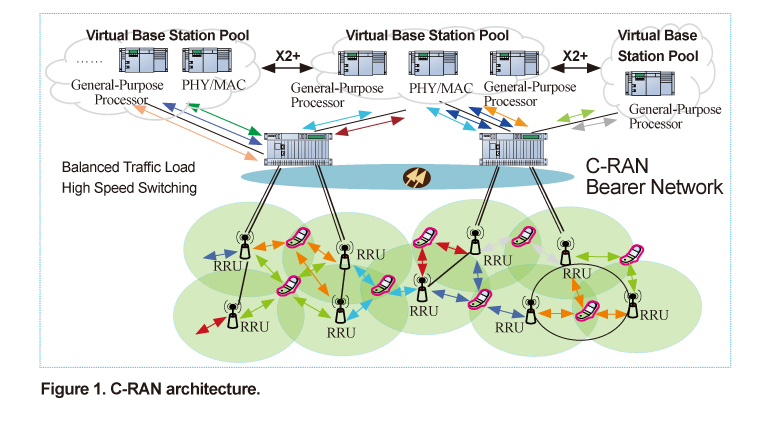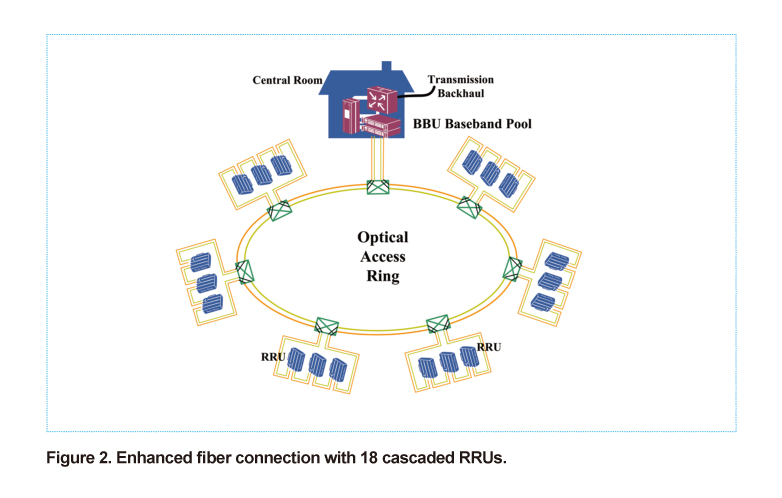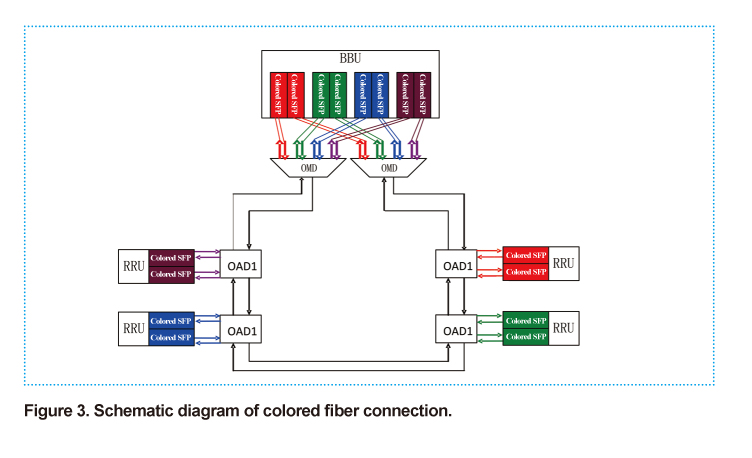C-RAN Bearer Network Solution
C-RAN is a centralized, cooperative, clean and cloud computing architecture in radio access networks. Baseband units (BBUs) in C-RAN are centrally deployed, which allows for baseband sharing, saves equipment room, and considerably reduces energy consumption and TCO. Cooperative radio also significantly improves network performance.
In a traditional mobile access network, the access network layer transmits signals at the A/lub interfaces. Signals are transmitted at a typical bandwidth of tens of megabits per second using MSTP/PTN. In C-RAN mode, BBUs are centralized, and the access network layer also needs to transmit signals at an Ir interface (that complies with the CPRI standard). Signals are transmitted at a typical bandwidth of several gigabits per second using fiber. C-RAN is applied in areas where there is abundant fiber. China Mobile’s branch in Zhuhai has adopted C-RAN, and Korea Telecom has also adopted it in its CCC network. In fiber-scarce regions, ZTE has developed an array of solutions, including enhanced fiber connection, colored fiber connection, and OTN bearer. All these solutions use a very few fibers to meet C-RAN bearer requirements in different scenarios.

Transmission Requirements for CPRI
In a RAN, different wireless systems need different bandwidths. Table 1 lists CPRI bandwidth requirements for site types of three typical wireless systems.

As well as specifying the bandwidth requirement, the CPRI standard also specifies that
- the transmission distance should be not less than 10km. (ZTE’s BBU can compensate a transmission length of 40km)
- jitter introduced into each RRU should be less than ±0.002ppm
- time synchronization for TD-SCDMA and TD-LTE base stations should be precise to ±1.5us. When the 1588 protocol is used in C-RAN for time synchronization, the recommended precision for transmission between BBU and RRU is ±100ns.
In a solution that does not use a transmission device, BBU-RRU can use CPRI overhead to perform basic OAM. In current network planning, C-RAN is used in the access network layer. The BBU pool is located at the border of the convergence layer and access layer, and 4 to 6 sites are connected to each ring.
C-RAN Bearer Network Solution
The core function of C-RAN is to transmit data at the Ir interface. Since IQ data at the Ir interface have large bandwidth and high jitter requirement and cannot be multiplexed or converged, it is impossible for traditional SDH/MSTP/PTN/PON/Switch bearer equipment to carry the IQ data. WDM is therefore used to solve the transmission issue in C-RAN.
Fiber connection is directly used for fast C-RAN deployment in areas with abundant fibers resources. There are two schemes available for areas where fiber is scarce. One is to use a few fibers to build an independent C-RAN by means of enhanced fiber connection or colored fiber connection. The other is to use outdoor OTNs as bearers.
Enhanced fiber connection
Because bandwidth for the CPRI link is small in a GSM network, a large number of RRUs can be cascaded to save fibers. Enhanced fiber connection allows for cascading of up to 18 RRUs through the CPRI interface (Fig. 2). A mature 6G optical module can be used for each RRU. Equipment at the radio side provides protection and OAM for enhanced fiber connection using CPRI signals.
With enhanced fiber connection, six GSM sites can be networked with only one pair of fibers. This is an optimal transmission scheme for GSM C-RAN.

Colored fiber connection
In colored fiber connection, WDM is used to configure optical multiplexers/demultiplexers (OMDs) in the BBU pool and optical add/drop (OAD) devices on the RRU nodes. Fig. 3 shows a configuration of four RRU nodes, each with an OAD1. Optimal modules on the BBUs and RRUs are colored (WDM) modules with certain wavelengths. CWDM is used to support a maximum of 18 wavelengths, and DWDM is used to support a maximum of 80 wavelengths.

Each wavelength connection between BBU and RRU is a physical point-to-point connection, so power budget is a key issue.
Power budget calculation is OAD insertion loss on a local add/drop path + OAD insertion loss on other nodes + OMD insertion loss + adapter loss + optical fiber loss + engineering margin < optical module power budget. For example, the power budget for a colored 8-wavelength CWDM fiber connection of six TD-SCDMA sites with a loop length of 20km is 1 + 5 × 1+2.5 + (8 + 5 × 2) × 0.5 + 0.25 × 20 + 3 = 25.5dB. At present, the power budget for a 6G colored optical module is 25dB, which meets the basic requirement for colored fiber connection in TD-SCDMA C-RAN. By increasing the power budget of colored optical modules, six TD-SCDMA sites with loop length of 40km can be color-fiber connected.
For future LTE, each site will need three 10G wavelengths, and colored CWDM fiber connection will still support four sites with a loop length of 20km. When DWDM and OA are used, six sites with a loop length of 40km are supported. For densely-deployed LTE sites where few changes have been made to the optical network topology, an OAD will be shared by more LTE sites. 24 LTE sites can be networked on a ring with a pair of fibers, and these sites will have a loop length of 40km.
OAM for colored CWDM fiber connection is similar to that for fiber connection. Wireless equipment provides protection and OAM through CPRI signals. OAD is a passive optical device that can be placed in an outdoor power cabinet or in an optical cross-connecting box. OMD and OA can be installed in the equipment room where a BBU pool is located. Through colored fiber connection, both TD-SCDMA and TD-LTE C-RAN bearer schemes can be implemented with only one pair of fibers.
OTN bearer
OTN is a WDM-based integrated bearer device. In the C-RAN bearer network solution, CPRI can be a service type carried by OTN. Various mapping schemes for CPRI over OTN have been defined in the ITU-T G.709 standard. The stringent requirements on CPRI jitter and delay can be fully met by using a proper network design.
As well as C-RAN, OTN also supports SDH, MSTP, PTN, PON and Ethernet transmission. Because OTN is introduced into the transmission layer, it provides perfect protection, OAM, and fault diagnosis and can support ring, tree (UniPON), and mesh topologies.
Traditionally, an OTN is used in a backbone transmission network, and the cost is high. When OTN is widely used as a C-RAN bearer, its functions can be implemented with an ASIC. This significantly cuts equipment cost. Moreover, no equipment room is needed for C-RAN application. Where a compact OTN is mounted on a corridor wall or on an outdoor pole, small industrial components reduce temperature and allow for better temperature control.
When OTNs are used in an access network, multiservice bearer requirements can be met by building new OTN transmission networks and expanding existing ones.
Conclusion
The primary issue in a C-RAN bearer network is the cost of fiber in large-scale deployments. For GSM C-RAN, ZTE provides an enhanced fiber connection solution that uses 18 cascaded RRUs to greatly save fiber resources. This solution has been commercialized. For TD-SCDMA C-RAN, ZTE provides a colored CWDM fiber connection solution that supports six networked sites (18 cascaded RRUs) with only one pair of fibers. Field tests for this solution are currently being carried out. The solution adopts mature DWDM, OA and FEC technologies that can be used to fully meet bearer needs of future LTE.
Enhanced fiber connection and colored fiber connection have advantages over traditional fiber connection. Both are low-cost C-RAN bearer network solutions that save fiber resources, protect the network, and perform OAM. With enhanced fiber connection and colored fiber connection, widespread C-RAN deployment is feasible. Moreover, outdoor OTNs can be used in
access networks as bearers for multivendor integrated services including C-RAN, broadband access and VIP dedicated lines.